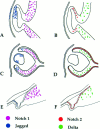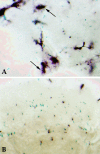The expression and function of Notch pathway genes in the developing rat eye
- PMID: 9006984
- PMCID: PMC6793727
- DOI: 10.1523/JNEUROSCI.17-04-01425.1997
The expression and function of Notch pathway genes in the developing rat eye
Abstract
The Notch gene plays a role in the development of disparate tissues in multiple organisms. Because the vertebrate eye is an excellent model system for both patterning and cell fate determination, two processes that can involve Notch, we examined the expression patterns of Notch 1 and Notch 2, and their ligands Delta and Jagged, in the developing rat eye. Notch 1 and Delta were found to be expressed in the neural retina during the period of cell fate determination and differentiation. Notch 2 was found to be expressed in the non-neuronal derivatives of the optic cup, including the pigment epithelium, optic stalk, and ciliary body. Jagged was expressed in distinct regions within the optic vesicle, ciliary body, and lens, with patterns that changed over time. The potential function of Notch 1 in cell-type specification and differentiation was examined by introducing a constitutively active form of Notch 1 in vivo using a replication-incompetent retrovirus. This form of Notch 1 was found to cause abnormal growth and interfere with the differentiation of multiple retinal cell types.
Figures








References
-
- Ahmed I, Zagouras P, Artavanis-Tsakonas S. Involvement of Notch-1 in mammalian retinal neurogenesis: association of Notch-1 activity with both immature and terminally differentiated cells. Mech Dev. 1995;53:73–85. - PubMed
-
- Alexiades MR, Cepko C. Quantitative analysis of proliferation and cell cycle length during development of the rat retina. Dev Dyn. 1996;205:293–307. - PubMed
-
- Artavanis-Tsakonas S, Matsuno K, Fortini ME. Notch signaling. Science. 1995;268:225–232. - PubMed
-
- Austin CP, Feldman DE, Ida JA, Jr, Cepko CL. Ganglion cells in the vertebrate retina are selected from an equivalence group regulated by Notch. Development. 1995;121:3637–3650. - PubMed
-
- Ausubel FM, Brent R, Kingston RE, Moore DD, Seidman JG, Smith JA, Struhl K (1996) Current protocols in molecular biology. New York: Greene/Wiley-Interscience.
Publication types
MeSH terms
Substances
Grants and funding
LinkOut - more resources
Full Text Sources
Medical
Research Materials
